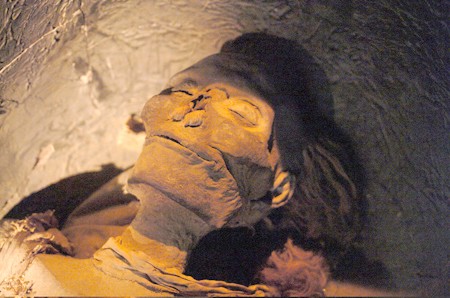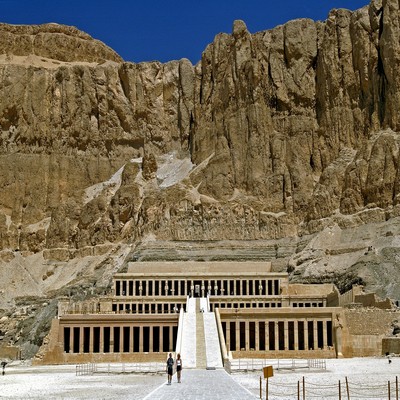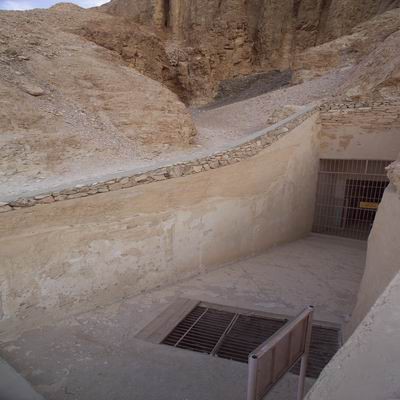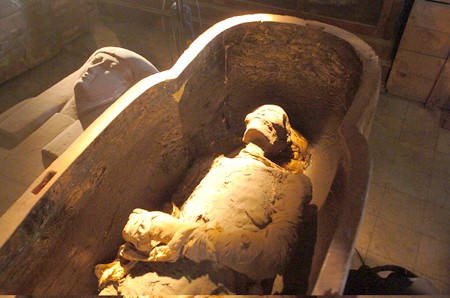“Egypt, The mummified remains of Queen Hatshepsut wet-nurse Sitre-In
Egyptian kings have magic for all of us. But even more than kings, queens—especially the great ones like Nefertiti and Cleopatra—capture our imaginations. It is perhaps Hatshepsut, who was both king and queen, who is the most fascinating.

We know that only four women became pharaohs in ancient Egypt. Three of these ruled at the end of dynasties, when power was slipping from the hands of the ruling houses. There was Nitokerty (Nitocris) from the end of the Old Kingdom; Sobekneferu at the end of the Middle Kingdom; and Queen Twosert, who ruled after the dynastic crisis at the end of the 19th Dynasty. In contrast, Hatshepsut ruled as a pharaoh during the golden age of Egyptian history, when Egypt ruled the East.
Recently, I was invited by Dorothea Arnold to give a lecture on Queen Hatshepsut on the occasion of the opening of the exhibition that is currently at the Metropolitan Museum of Art in New York. Hatshepsut, which means “united with Amun in front of the nobles,” was the daughter of Thuthmosis I and Queen Ahmose. She married her brother Thuthmosis II and had one daughter Neferure. She was the fifth queen of the 18th Dynasty, and had many great titles during this time. Some believe that her title “the divine wife of Amun” was her passport to becoming the pharaoh. After the death of Thutmosis II, a son of a secondary wife Isis, Thuthmosis III, became the king, with his wife and stepmother, Hatshepsut, as his regent.
After a few years as regent, Hatshepsut ascended to the throne beside her nephew, and became a full co-ruler. The concept of divine kingship in ancient Egypt has its roots in religious myth, which defined the roles of both kings and queens. Principal among these myths was the story of Isis and Osiris, in which the latter was one of the mythical divine rulers of Egypt and the former was his consort. Osiris was killed and dismembered by his brother Seth, after which Isis collected the pieces of her husband’s body and brought Horus, the son of her union with Osiris, to take revenge on his uncle Seth and take over the throne of the Two Lands. The identification of the king with the god Horus and the masculine principle of fertility, symbolized by a bull, meant that the king’s role could not adequately be fulfilled by a woman. In ancient Egypt, the king was always associated with male images, such as the bull and the falcon, while his queen was identified with the vulture goddess Nekhbet. Thus a woman, according to religious dogma, could not take the office of pharaoh.

However, the king could not rule alone, but had to have a woman as his counterpart. Without Isis, the kingship could not function; thus queenship was a counterpart and balance to kingship, with its own well-defined mythical and ritual roles. The two offices were intertwined, and mutually dependent, but fundamentally different and not interchangeable.
When Hatshepsut took the kingship, she had to create a new story of her divine birth from the god, which would be shown on her temples in order to convince the people that she was actually chosen by the god. She had herself depicted in the traditional male garments of the pharaoh, with all of the usual kingly iconography.
Hatshepsut counted the years of her reign from Thuthmosis III’s accession. Although he is occasionally depicted as co-regent as on the blocks from the Red Chapel at Karnak, she was always the dominant partner. After she became king, she undertook a very ambitious building program at Deir El-Bahari where she depicts the story of her divine birth. This temple is one of the jewels of ancient Egyptian architecture. Rising in three terraces against the golden cliffs of western Thebes and culminating in a rock-cut shrine of Amun, it remains a fitting monument to this exceptional queen. In addition to other constructions at Karnak and Speos Artemidos she sent an expedition to Punt and made many statues representing herself as king. She ruled for about 20 years, and then disappears from the historical record.

The story of Hatshepsut is wonderful and really took hold of me recently. My research has always been connected with the Old Kingdom pyramids. I never thought that I would go to the Valley of the Kings. However, I began my career as a young archaeologist 35 years ago on the west bank of Luxor and have many good memories of that time. Last year, I made a visit to the Valley of the Kings, specifically KV20, the tomb of Hatshepsut, as well as KV60 in order to search for the mummy of this great queen.
KV20 was known before Howard Carter began his work in the Valley of the Kings. The French expedition under Belzoni recorded the tomb in 1824. Later, James Burnton re-cleared it and reached the stairs or the second step. Carter then began working in this tomb. It is a double tomb, for Queen Hatshepsut and her father Thuthmosis I. Based on vessels bearing the name of Tuthmosis I, Carter attributed KV 20 to this king, and suggested that Hatshepsut, whose sarcophagus was found here as well, was buried there later. However, it is more likely that it was built by Hatshepsut, and that she later brought her father’s body here to accompany her into the afterlife. A tomb carved for Hatshepsut while she was a queen lies in the cliffs at Wadi Zayed Sikket[]. [1]
KV 20 consists of 4 tunnels, each about 213 meters long. Over the course of their length, the tunnels bend to form a half circle. It is believed that the tomb took this shape so that it would end at the axis of the temple of Queen Hatshepsut at Deir El-Bahari, and the burial chamber would lie directly beneath the holy of holies. However, the tomb was not completely finished. [2]
In 1902, Howard Carter and Theodore Davies discovered a sarcophagus made of sandstone inscribed for Hatshepsut as a pharaoh in the burial chamber; this is now at the Egyptian Museum, Cairo. A second sarcophagus, also found in the burial chamber, belongs to her father, Thuthmosis I. This was either transferred to KV 20 from his original tomb, or ordered by Hatshepsut so that she could move her father’s body into it. It is now in the Museum of Fine Arts, Boston. The mummy of Thuthmosis I was transferred by Thuthmosis III and reburied again in a new tomb, KV 38. In KV 20, Carter and Davis also discovered a box of canopic jars belonging to the female pharaoh. The tomb was not inscribed but 15 blocks of limestone were found, on which had been painted, in red and black, scenes and text from the Book of the Amduat, or What is in the Netherworld. Shawabtis were also found with the features of Hatshepsut, and stone vessels inscribed with the names of Ahmes-Nefertari, Thuthmosis I, Ahmose, and Hatshepsut. Wooden fragments of a head and feet from a large statue were discovered in the tunnel that preceded the burial chamber. [3]

When I came last year to visit the tomb of Hatshepsut (KV 20), I decided to open KV60 as well. This tomb was first discovered by Carter in 1903. It lies in front of the entrance of KV 19, the tomb of Montuhirkhopshef, and is not far from KV 20. Inside, he found mummified geese and other meat offerings, and the bodies of two elderly women, one in a coffin labeled with the name and title of the Great Royal Nurse, In, and the other lying uncoffined on the floor. He removed only the geese, and closed the tomb again.[4] The tomb was subsequently reopened in 1906 by Edward R. Ayrton and Theodore Davis, who moved the coffin and the mummy it contained to the Egyptian Museum, Cairo in 1908.[5] According to Forbes, the extraction of In-Sitre from this tomb by Ayrton is speculative, as there is no previous record of her removal. It was registered at the museum in 1916 as TR 24.12.16.1, with a note that it was recognised by Carter as having been found by him near Mentuherkhepshesef in 1903 and brought away later, by Ayrton (?). Since that time, the mummy and its coffin have remained, neglected, in the attic of the museum, and until now there were no photographs available of either. The inscription on the coffin has led scholars to identify the coffin and its inhabitant as the wetnurse of Hatshepsut, Sitre In, known from a sandstone statue found at Deir el-Bahari (JE 56264). as the wet-nurse of Hatshepsut. [6] The remaining mummy in the tomb is in the so-called “queen’s pose” with one arm placed diagonally across her breast. After Ayrton and Davis, the tomb was re-sealed with the denuded corpse still in situ. The tomb was opened for the third time for full and official clearance by Donald Ryan of Pacific Lutheran University Valley of the Kings project. Ryan. This mummy was photographed, examined, and a box made in which to store it more safely.
I went to see KV 60 with Salima Ikram, to examine the mummy for a television documentary. When the inspectors of antiquities opened this tomb for me, we removed the modern covering and descended a set of rough stairs leading to a tunnel with niches on both sides. Then, with some difficulty, we were able to enter the burial chamber. This was left unfinished and was never decorated. It might have been a perfect place to hide mummies in the pharaonic period. There have been three royal caches found in the Valley of the Kings: KV35 in 1898; KV55 in 1907; and the tomb of Horemheb in 1908; neither these, nor the royal mummy cache at Deir el-Bahari, contained a mummy identified in any way as Hatshepsut.
Some scholars believe that Hatshepsut was buried in the tomb at Wadi Sikket Taqqet el-Zaid , prepared for her while she was a queen. Elizabeth Thomas has suggested that the mummy left behind in KV 60 is Hatshepsut [7] Ryan has also proposed (following upon Elizabeth Thomas’s hypothesis) that the mummy left in KV 60 might be the missing corpse of Hatshepsut. However, I do not believe that this mummy is Hatshepsut. She has a very large, fat body with huge pendulous breasts; and the position of her arm is not convincing evidence of royalty?
I appointed several curators at the Egyptian Museum, Cairo to look for the second mummy, the one moved by Ayrton in 1908. They were able to discover that it is located on the third floor of the museum, where it was examined on my behalf. The badly damaged coffin is typical of the 18th Dynasty. Among the remaining inscriptions is wr Sdt nfrw nswt In, great royal nurse In.” The mummy inside is about 1.5 m. tall but the coffin is 2.13 m, suggesting that the coffin was not originally intended for this mummy. The obese mummy still in the tomb is significantly taller, and would fit much better in the coffin.
The mummy at the Egyptian Museum has her right hand down by her side and her left hand across her abdomen with the hand closed as if it was originally holding something. She was well mummified, in fine linen, with the fingers wrapped individually. The toes were evidently wrapped together; this wrapping has been torn away, as if the robbers were looking for gold. The woman was eviscerated through a U-shaped incision in the abdomen. She has long curly hair remaining on her head. I think the face is quite royal, and believe that anyone who sees it will have the same reaction. There is also a mass of linen at the bottom of the coffin but this is not of the same quality.
I suggest that in the Third Intermediate Period, during the 21st or 22nd Dynasties, the priests moved the mummy of Hatshepsut to KV60, which possibly was cut in the 18th Dynasty but never used, or perhaps was originally intended for Sitre Iin. The priests moved the mummy of Hatshepsut from KV20 to KV60 for reasons of security reasons, as they had in many tombs in the valley. The mummy of Hatshepsut could have been moved to the coffin of her wetnurse for security, or as a mark of respect.
The body of the mummy now in KV60 with its huge breasts may be the wetnurse, the original occupant of the coffin at the Egyptian Museum, Cairo. Therefore, the mummy on the third floor at the Egyptian Museum, Cairo could be the mummy of Hatshepsut.[8] Plans are being made to move the mummy from KV60 to the Egyptian Museum, Cairo, and a special exhibition of the two mummies is being organized.
Related Post
A shocking documentary proves that mermaids do exist
SHOCKING Revelation: Thuya, Mother of Queen Tiye, Was the Grandmother of Akhenaten and Tutankhamun—What Ancient Egyptian Secrets Did She Leave Behind?
Breaking News: Astonishing Discoveries at Karahan Tepe Confirm an Extraterrestrial Civilization is Hiding on Earth, and NO ONE Knows!
Breaking News: Researchers FINALLY Discover U.S. Navy Flight 19 After 75 Years Lost in the Bermuda Triangle!
NASA’s Secret Investigation: Uncovering the Astonishing Mystery of the UFO Crash on the Mountain!
Explosive UFO Docs LEAKED: Startling Proof That Aliens Ruled Ancient Egypt!